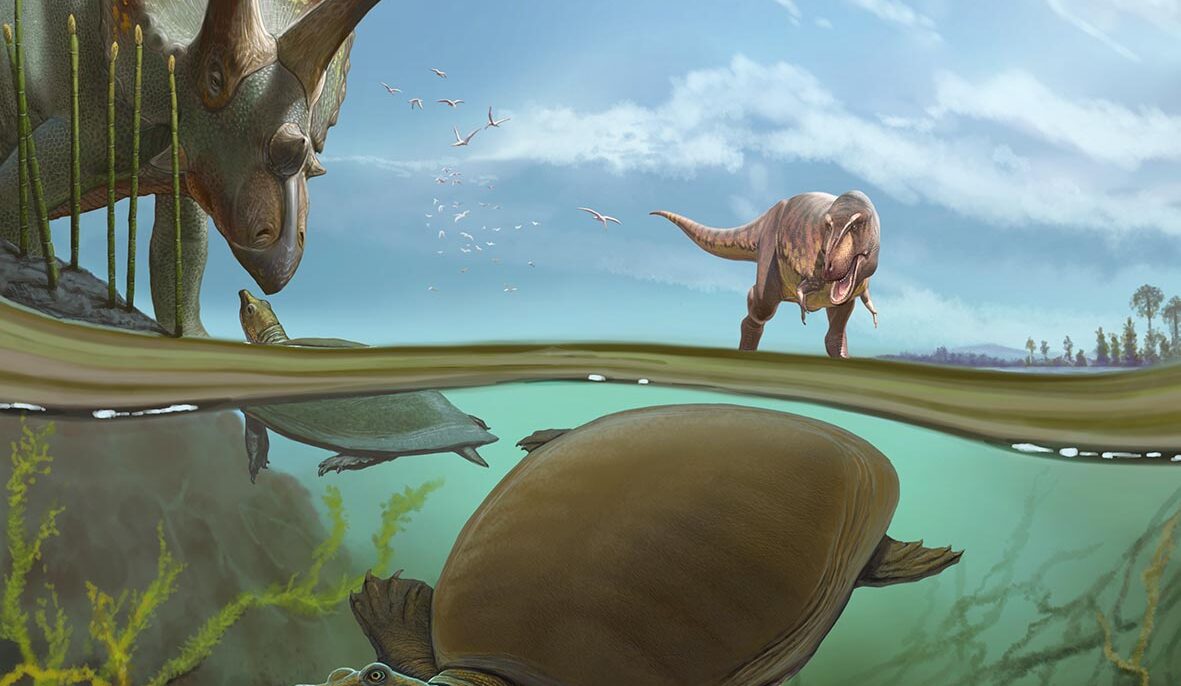A group of researchers, led by Harrisburg University of Science and Technology Professor Dr. Steven Jasinski, recently named and described a newly discovered species of softshell turtle, adding another new species to the list of fossil animals Jasinski has recently named.
Jasinski, of HU’s Department of Environmental Science and Sustainability, and researchers from Appalachian State University, the New Mexico Museum of Natural History and Science, and the University of Pennsylvania, described Hutchemys walkerorum, a newly discovered softshell turtle from North Dakota that lived 66.5 million years ago at the end of the time of the dinosaurs.
The team reported their findings in a paper recently published in the journal, “Cretaceous Research.” The research was published by Jasinski, Andrew Heckert and Ciara Sailar of Appalachian State University (ASU), Asher Lichtig and Spencer Lucas of the New Mexico Museum of Natural History and Science (NMMNHS), and Peter Dodson of the University of Pennsylvania (UP).
With a kind of leathery shell, Hutchemys walkerorum were softshell turtles that represent one of the earliest known species of the genus. These turtles became more common after the mass extinction event at the end of the Cretaceous Period, the same one that killed off the dinosaurs, although not the birds. It would have been a relatively small turtle, with a shell approximately 8 to 10 inches long. We still have species of softshell turtle today and they tend to live in water environments with muddy bottoms where they can partially bury themselves.
The fossil bones were discovered in Late Cretaceous rocks of the famous Hell Creek Formation in southwestern North Dakota and were collected by scientists and students from Appalachian State University in 1975. The specimen was in storage at ASU for nearly 40 years before Jasinski was invited to look further into it and begin studying it.
Hutchemys walkerorum belongs to a particular group of softshell turtles in the Trionychidae family called plastomenines. These turtles are similar to the softshell turtles that exist today, although the plastron of plastomenine turtles, the bones covering their stomach and abdominal area, are more strongly sutured together and often larger and more robust than in other softshell turtles.
Plastomenines lived during the Cretaceous and Paleogene periods, around 80 million to 50 million years ago. Members of this group first appear in the fossil record during the Late Cretaceous, and a single species continues into the Eocene Epoch, 50 million years ago, but they are at their peak diversity before and after the Cretaceous-Paleogene boundary.
“Until recently we didn’t understand these softshell turtles very well,” says Jasinski. “However, we are starting to get more information on this extinct group of turtles and further understanding their evolution, including how they dealt with the mass extinction.”
Hutchemys walkerorum is known from the carapace, the bones that cover the turtle’s back and what people often think of when they think of a turtle’s shell. There are several key features of the shell, including how it is shaped and its curvature, that distinguish it from other known turtles.
Hutchemys walkerorum was also discovered close to a specimen of Triceratops. In addition to Triceratops, the Hell Creek Formation is well known for the presence of Tyrannosaurus rex. This means that Hutchemys walkerorum, a softshell turtle less than a foot long, would have been living in the ponds, streams, and slow-moving rivers in North Dakota 66 million years ago in the shadow of T. rex and Triceratops, giving us a clearer picture of the Cretaceous world at that time.
“With this study we gain further insight into winners and losers during the cataclysm that ended the Age of Dinosaurs,” says Dodson. “The mighty dinosaurs fell and the lowly turtle survived.”
A phylogenetic analysis, comparing the new species with other known trionychids or softshell turtles, gave the scientists a better understanding of the group’s evolutionary relationships. Their analysis placed Hutchemys walkerorum with other known species of Hutchemys and several other turtles in a distinct group of derived plastomenines, which they named Plastomenini. Additionally, the researchers found a group of early trionychids, placing them in a newly established subfamily, Kuhnemydinae. Kuhnemydines are fossil species from Asia, and the team’s analysis suggests the family Trionychidae originated in Asia before migrating to North America sometime in the Late Cretaceous.
The researchers’ investigations also led them to another new classification in the Trionychidae family, a subfamily they named Chitrainae. This group encompasses modern softshell turtles, including the narrow-headed and giant softshell turtles found in southern Asia.
“This discovery is important not only for understanding the evolution of these interesting turtles, but also the world that T. rex and Triceratops lived in,” said Jasinski. “With each new discovery, we gain a little more understanding of the way things were, and it makes it easier to envision this turtle poking its head out of the water watching a Triceratops lumber by or T. rex stopping to get a drink. Further understanding that amazing world is one of the things that continues to reinvigorate my research and desire to continue learning.”
To read the team’s paper describing the Hutchemys walkerorum, visit this link.
Jasinski also was a member of other teams that recently named and described new horned dinosaurs discovered in New Mexico. He and his groups of researchers recently named the dinosaur species Menefeeceratops sealeyi and Sierraceratops turneri. To learn more about this discovery, click here.
ABOUT HARRISBURG UNIVERSITY
Accredited by the Middle States Commission on Higher Education, Harrisburg University is a private nonprofit university offering bachelor and graduate degree programs in science, technology, and math fields. For more information on the University’s affordable demand-driven undergraduate and graduate programs, call 717-901-5146 or email, Connect@HarrisburgU.edu. Follow on Twitter (@HarrisburgU) and Facebook (Facebook.com/HarrisburgU).
